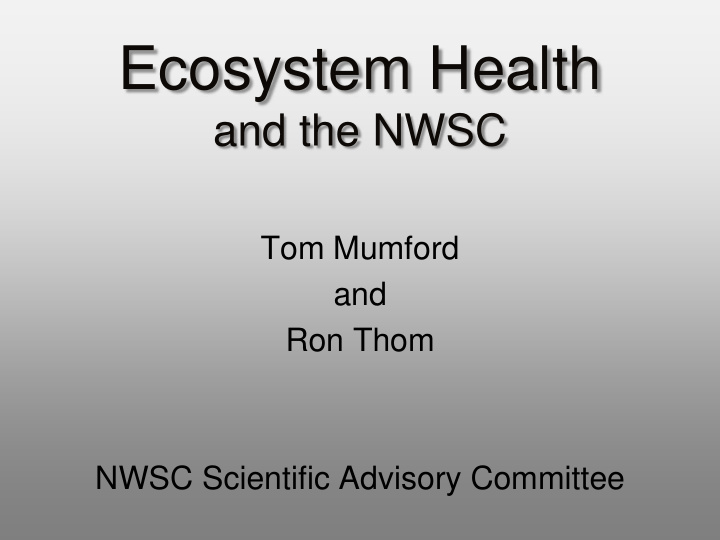



Ecosystem Health and the NWSC Tom Mumford and Ron Thom NWSC Scientific Advisory Committee
Ecosystem Health and the NWSC “Overall ecosystem health should be our primary goal” “Reach out to the public and other key constituencies on such issues as the link between healthy marine habitat and healthy resources and how MPAs can play an important role in habitat protection.” “The long-term economic health of local communities is tied to the health of natural systems in the area.” Murray-Metcalf Northwest Straits Citizens Advisory Commission “Report to the Convenors” August 20, 1998
Ecosystem Health and the NWSC “Based on its achievements thus far, its potential for providing greater benefits in the future, and the continuing need for action to improve the health of the Northwest Straits marine ecosystem, the Evaluation Panel strongly and unanimously makes the following recommendations:” “Northwest Straits Marine Conservation Initiative Five-Year Evaluation Report”. Submitt by the Northwest Straits Evaluation Panel, April 6, 2004
“Ecosystem Health” as a paradigm • Subjective approach – The language and discussion of ecosystem health is value laden but how are societal values and preferences to be incorporated when using ecosystem health in public policy? The crux of the policy challenge is deciding which of the diverse set of societal preferences are to be adopted. Resolving policy issues always consists of tradeoffs , partially or entirely exclusive alternatives, winners and losers, and plenty of compromises. (Lackey 2003)
Assumptions? • Individual health vs. ecosystem health? • Ecosystem health or ecological integrity? • Vague benchmarks or quantifiable goals?
Moving Forward… • Is ecosystem “health” a good paradign to be following? • Are these the “Right” Benchmarks/Indicators? • How are we connected to them? • How are connected to other efforts?
How are we interacting with the Puget Sound Partnership? • What common measures of Health do we share ? • Are there others or different ones? • Are there opportunities for synergies between the NWSC and PSP? (and others?)
Benchmark #6: PSP Key Marine Indicator Vital Signs and Species indicators • Forage fish spawning site Biomass of spawning Pacific herring inventory and mapping • Olympia oyster restoration No Chinook salmon abundance as measured by the number • Salmon surveys of natural run adult fish returning to spawn • Kelp surveys No
Recommendation Baseline, monitoring, and ecosystem research and data • …it has been difficult to measure progress on specific benchmarks because sufficient baseline data have not been collected or compiled. • At the completion of the next phase, the Initiative will have to have documentation of ecosystem improvements if it is to garner continued support. • will require funds in excess of current core support. • funds are insufficient in themselves to support the breadth of work needed, but they could be used to leverage other funds or support other agencies in the effort. • important to coordinate with other entities involved in this work, such as – Puget Sound Action Team (PSAT), – Puget Sound Nearshore Ecosystem Restoration (PSNER) partnership, – Pacific Northwest Aquatic Monitoring Partnership (PNAMP), – NOAA Fisheries, and the – Salmon Recovery Funding Board.
Potential To Do’s: Defining Objectives • “Health” – for what/whom, based on what services/benefits • Indicators – measured by what • Thresholds – how do you know you've reached your objectives
Other Potential To Do’s: • Create a simple conceptual model linking the actions that the MRCs take with the metrics used to measure the target. • Educational efforts by the MRC's can be a significant part of a strategy to attain the overarching goal
Other Efforts • Ocean Health Index (Halpern et al.,2012) • European Water Framework Directive (Birk et al.,2012) • Marine Strategy Framework Directive (Borja et al.,2016)
References Birk,S. et al.,2012. Three hundred ways to assess Europe’s surface waters: An almost complete overview of biological methods to implement theWater Framework Directive .Ecol. Indic.18,31–41. Borja, A. et al., 2016. Overview of integrative assessment of marine systems: the Ecosystem Approach in practice. Front. Mar. Sci., 3. http://dx.doi.org/10.3389/ fmars.2016.00020. Halpern,B.S. et.al. ,2012. An index to assess the health and benefits of the global ocean. Nature 488,615–620. Lackey, R. T. 2001 Values, policy, and ecosystem health. Bioscience, 51(6): 437-443. Lackey, Robert T. 2003. Appropriate use of ecosystem health and normative science in ecological policy. pp. 175-186. In: Managing for Healthy Ecosystems, David J. Rapport, William L. Lasley, Dennis E. Rolston, N. Ole Nielsen, Calvin O. Qualset, and Ardeshir B. Damania, editors, Lewis Publishers, Boca Raton, Florida, 1510 pages.
Recommend
More recommend